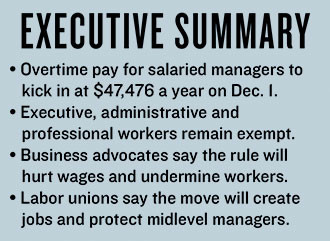
Jimm Swafford moved to hourly pay for managers in 2015.
The Obama administration and the U.S. Department of Labor have set a new overtime rule that is as far-reaching as it is divisive.
Under the Fair Labor Standards Act, federal regulators moved on May 18 to more than double the minimum salary threshold – from $23,660 a year to $47,476 – for which many salaried workers are eligible to receive overtime pay. Set to begin Dec. 1, the change is expected to affect 4.2 million employees in its first year, and nearly 45,000 – or 2 percent – of Missouri’s workforce, according to the DOL.
On one side are business advocacy groups, including the Springfield Area Chamber of Commerce and the National Federation of Independent Business, saying the government is out of touch with business realities and the new rule is bad for workers and companies. On the other, labor-centered organizations, such as the National Employment Law Project and the Economic Policy Institute, argue the rule benefits employees and strengthens the economy.
But at Jimm’s Steakhouse & Pub on South Glenstone Avenue, Managing Partner Jimm Swafford saw the rule change coming and took action ahead of regulators. He moved the restaurant’s three managers to hourly rates in January 2015, and it’s paid dividends.
“I think there is a little higher morale. When they do work excessive hours, they are rewarded for it,” he said, noting the change hasn’t affected restaurant employment levels.
A key point in the rules is that overtime exemptions remain for CEOs, such as directors of nonprofits; administrators, including retail general managers; and creative professionals, such as journalists.
Springfield chamber President Matt Morrow counters the DOL secretary’s position that the rule would move millions of employees into the middle class.
“This logic reflects a fundamental lack of understanding of how jobs are created and what leads to wage growth and upward mobility for workers. The sad reality is any public policy based on this understanding of economics actually has the opposite effect: It will lead to fewer jobs and lower wages for far too many American workers,” Morrow said.
Competing takes
Dan Bosch, senior manager of regulatory policy for the NFIB, said about 40 percent of its 325,000 small-business members would be impacted by the rule change.
“Because of the dramatic increase in the salary threshold, they can’t afford to bump up their pay to that level to keep them salary exempt,” he said, adding many firms plan to simply reduce hours to avoid paying overtime or move to an hourly rate equivalent to current salaries. “The promise of the DOL of more pay is entirely up to the business owner and whether they can afford it. Overwhelmingly, particularly for small businesses, the answer is they can’t afford it.”
The DOL estimates annual direct costs for employers will be roughly $295 million per year over the first 10 years.
“It is certainly another instance of the government trying to mandate pay raises for individuals beyond what the market is bearing, so that aspect of it is problematic,” Bosch said.
NFIB members say the rule will force them to restructure employee positions and schedules, which will take time away from running their businesses.
The left-leaning EPI estimates 12.5 million workers would benefit from the new rule, including 257,000 from Missouri – over one-fourth of the workforce – based on its analysis of current wages.
Christine Owens, executive director for the National Employment Law Project, a research and advocacy group supporting protections for workers and higher wages, said the DOL move ensures fairer pay for those overworked.
“It’s not at all unusual at the low end of the economy – fast food, low-end retail, etc. – to find individuals who are paid only a little bit above that threshold and are working 50 to 60 hours a week,” she said.
Additionally, she said the rule change incentivizes employers to add jobs.
“One of the reasons overtime came into being during the Great Depression was that the extra cost of time-and-a-half pay actually becomes an inducement to create more jobs rather than bear the costs,” Owens said, pointing to the National Retail Federation, which has opposed the rule change, but estimated the move would add over 100,000 new jobs.
According to NRF.com, the study Owens and others refer to – conducted by Oxford Economics for the retail association – concluded the overtime rule would create 117,000 part-time jobs. The thrust of the study, according to the NRF, was that the current economy will prompt many employers to cut workers’ base pay, limit hours and reduce benefits due to costs associated with the new overtime rules.
Wage tables
At Jimm’s Steakhouse, Swafford said he supports a move up in the salary threshold but would have preferred it in the $40,000-$42,000 range.
“I think they’re still a little bit high,” he said.
Swafford set his managers’ hourly wages to reflect an estimated 50-hour workweek, with 10 hours coming from overtime. He said the switch resulted in some added flexibility, with managers able to work up to 55 hours a week, and it has not changed the restaurant’s annual payroll.
“I’ve been in this industry for 48 years, and I was abused as an assistant manager years ago making $29,000 and working about 72 hours a week. I’ve tried not to pass that on to my staff,” he said. “I don’t think it’s going to cost a lot of jobs. I think a lot of folks are going to see a fairer wage for themselves.”
